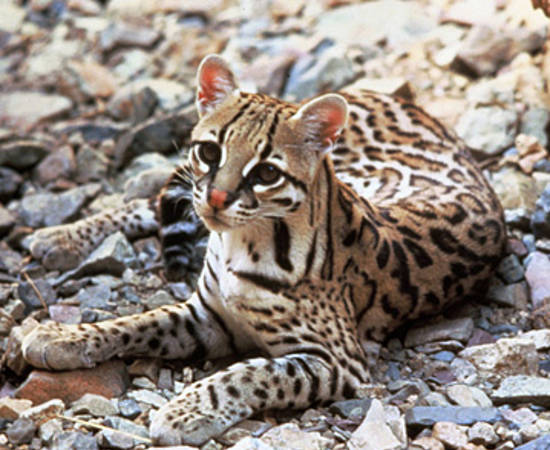

Educating and equipping landowners and stakeholders is crucial for effective management of wildlife and natural resources in Texas. With most of the state’s land privately owned, these individuals play a pivotal role in conserving habitat, protecting native species, and ensuring water and soil health. Providing landowners with knowledge, resources, and best management practices empowers them to make informed decisions that benefit both their property and the broader ecosystem. This collaborative approach not only supports biodiversity and sustainable use of natural resources but also fosters community stewardship, helping to address challenges such as habitat loss, invasive species, and changing environmental conditions across Texas.
Two of our cornerstone projects are the Recovering Texas Ocelots initiative and the Wild Pig Management program.
Recovering the Texas Ocelot
The ocelot (Leopardus pardalis) is a small wild cat species that currently occurs from northern Argentina up to the southern tip of the United States, where ocelots are found in Texas and occasionally in Arizona. The International Union for the Conservation of Nature considers ocelots as a species of “Least Concern” for extinction range-wide, though the overall ocelot population is decreasing, and ocelots are considered endangered in some countries. In the United States, the ocelot has been classified as federally endangered under the Endangered Species Act since 1982.
Historically, ocelots’ range in the United States is believed to have extended throughout Arizona, Texas, Arkansas, and Louisiana. However, historic overexploitation from unregulated hunting, trapping, and poisoning plus destruction and fragmentation of habitat has left ocelots vulnerable to extirpation from the United States. Today, resident breeding ocelots in the United States may number fewer than 100 individuals the wild. All of these breeding individuals occur in deep south Texas near the Gulf of Mexico. Due to their low numbers and isolation from other ocelot populations in Mexico, ocelots in the U.S. are threatened by low genetic diversity. This leaves them vulnerable to the negative impacts of genetic defects, which may be caused by inbreeding, and diseases. Further, because ocelots in Texas all live in low-elevation coastal areas, some worry that the viability of the entire existing U.S. breeding ocelot populations and their habitat could be lost in a single local catastrophic event, such as a high-impact tropical storm along the Gulf coast.
This project has established a visionary, proactive and cooperative blueprint for pooling the strengths, expertise, interests and resources of a diverse set of partners. Partner organizations designing the ocelot reintroduction program represent government agencies, non-governmental organizations, academic institutions, and private landowners. The partners include U.S. Fish and Wildlife Service, the Texas Parks and Wildlife Department, Lindner Center for Conservation and Research of Endangered Wildlife at the Cincinnati Zoo and Botanical Garden, zoological institutions, the Texas A&M University Natural Resources Institute, Caesar Kleberg Wildlife Research Institute, the Karen C. Drayer Wildlife Health Center at University of California Davis, Duquesne University, and East Foundation.
Each organization brings unique and relevant expertise in wildlife science and conservation. This effort has demonstrated how diverse entities can leverage their capabilities to create plans to recover an iconic endangered species on privately owned lands.
Read more about this partnership and the project at recovertexasocelots.org.
Wild Pig Management in Texas
Wild pigs are one of the greatest invasive species problems in the United States. They impact water quality, agricultural crops and livestock, wildlife populations and their habitats, and more recently, suburban landscapes. Nationwide, the population is estimated at about 4 million animals — with 2.6 million in Texas alone.
Wild pig crop damages and control costs are reported to be greater than $1.5 billion across the nation and conservatively $52 million in Texas, annually. In areas where wild pig populations are concentrated or in and near streams, where they spend a significant portion of their time, they contribute bacteria and nutrients to water bodies. These populations can substantially impact water quality by eroding banks, increasing sediment loads and algae blooms, and causing oxygen depletions.
Through presentations, publications, smartphone applications, social media content and videos, we are helping the public understand how these animals live, as well as improving the reduction measures used by landowners to control this pest. Our work has helped many stakeholders actively involved in implementing water resource management and protection programs in their watersheds. Providing education to landowners about effective removal and management strategies is crucial to successfully reducing wild pig populations and improving the water quality of Texas streams.
-
Enabling endangered species conservation on private land: A case study of the ocelot in Texas
May 2025
Lindsay Martinez, Tyler Campbell, Roel Lopez -
Long live the cat: Ocelot population viability in a planned reintroduced population in Texas, USA
Nov 2024
Lindsay A. Martinez, Jason V. Lombardi, Israel D. Parker, Forrest East, Tyler A. Campbell, Roel R. Lopez -
Disease Concerns Associated with Feral Pigs
Sep 2024
Josh Helcel, James Long, James Cathey -
Assessing ecological and socio-political factors in site selection for ocelot reintroduction in Texas
Mar 2024
Lindsay A. Martinez, Jason V. Lombardi, Garrett Powers, Amanda D. Anderson, Tyler Campbell, Roel R. Lopez -
Feral Hogs and Droughts
Apr 2023
Mikayla Killam and John M. Tomecek -
Feral Hog Pullers
Jan 2023
Mikayla Killam, David S. Trevino, Robert G. Sims, and John M. Tomecek -
Managing Feral Hogs on School Grounds: An Integrated Pest Management Approach
Oct 2022
Mikayla Killam Michael J. Bodenchuk, and John M. Tomecek -
Wild pigs negatively impact water quality: Implications for land and watershed management
Feb 2018
Josh Helcel, Forrest Cobb, Dr. James Cathey -
SP-472: Feral Hog Population Growth, Density and Harvest in Texas
Sep 2012
J. Timmons, B. Higginbotham, R. Lopez, J. Cathey, J. Mellish, J. Griffin, A. Sumrall, K. Skow









